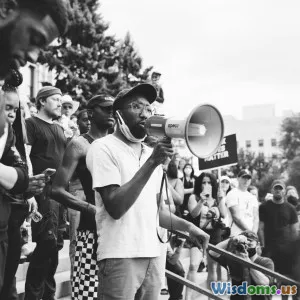
Why National Anthems Become Powerful Symbols During Times of Conflict
8 min read Explore how national anthems unite and empower nations during conflicts as powerful symbols of identity, resilience, and hope. (0 Reviews)
Why National Anthems Become Powerful Symbols During Times of Conflict
National anthems often evoke a profound sense of pride and patriotism in everyday life, but during times of conflict, their significance escalates far beyond ceremonial functions. They transform into rallying cries that unite diverse populations, sustain morale amid adversity, and symbolize a nation's enduring identity and hope for the future. But what is it about these melodies and words that imbue them with such potent symbolic power? This article delves deep into the reasons why national anthems take on amplified meaning during conflict, from historical origins to psychological effects and global case studies.
The Historical Roots of National Anthems as Symbols
National anthems typically emerge during or shortly after pivotal moments in a country’s history, often linked to struggle, independence movements, or foundational change. Their words and melodies are crafted to reflect ideals such as freedom, sacrifice, and unity — themes resonant during turmoil.
-
Case study: “La Marseillaise” — France’s Revolutionary Cry: Composed in 1792 during the French Revolution, “La Marseillaise” was originally a war song that galvanized citizens to defend the young republic. Its stirring rapids of musical phrasing align with the urgency of resistance and struggle. Today, it retains its potent association with courage in battle and unity against tyranny.
-
The South African “Nkosi Sikelel’ iAfrika”: First written in 1897 as a Christian hymn, it was transformed into a symbol of resistance during the apartheid era. Singing the anthem was an act of defiance amidst repression, linking it deeply to hopes for reconciliation and freedom.
These examples underscore how national anthems often root themselves in moments of collective hardship or transformation, making them intrinsically linked to conflict and resistance.
Psychological Functions of Anthems During Conflict
From a psychological perspective, music has a unique ability to influence emotions, cognition, and social behavior. National anthems combine lyrical content with evocative melodies to fulfill several critical functions during crisis:
1. Fostering National Unity and Collective Identity
Conflicts tend to exacerbate internal divisions, so anthems serve as auditory symbols consolidating disparate groups under a shared identity. Listening to or singing a national anthem activates a sense of belonging and common purpose.
- Research Insight: Studies by social psychologists reveal that shared musical rituals, especially patriotic anthems, increase social cohesion and reduce intergroup tension, pivotal when morale could falter.
2. Enhancing Morale and Resilience
The cadence and often uplifting tone of anthems can trigger feelings of pride, courage, and hope. These emotional boosts are critical to sustaining civilian endurance and soldier motivation during prolonged adversity.
- Example: In World War II, British broadcasts frequently played “God Save the King” to bolster public morale amidst bombings during the Blitz, reinforcing determination.
3. Serving as a Declaration of Legitimate Sovereignty
Anthems played on conquered or contested territory assert a nation’s claim and invite citizens to reinforce allegiance. This performative aspect is a symbolic form of power and resistance.
- Historical Note: During conflicts involving partition or occupation, such as the India-Pakistan divisions, the separate singing of each country’s anthem solidified separate national identities.
National Anthems on the Modern Battlefield and Beyond
Today, national anthems continue to transcend their ceremonial origins, adapting into multimedia contexts and symbolic acts:
Anthem Performances at Diplomatic and Military Events
International sports fixtures, summits, or wartime events often open with or evoke flags and anthems to signal sovereignty and unity. Notably, anthems serve as powerful psychological tools during key moments of diplomatic tension or military ceremony.
Case Study: 1990 Gulf War and National Anthem Broadcasts
During the Gulf War, Allied countries frequently broadcast their national anthems on radio and television to foster home-front solidarity. Citizens reported the anthems offering comfort and a feeling of collective purpose.
Digital Age and Nationalism
Social media now amplifies anthem performances, which can rapidly spark patriotic fervor or political protest. One example is the use of the Ukrainian national anthem amid the ongoing conflict with Russia; widely shared videos of citizens singing in public squares foster international awareness and solidarity.
The Complexity: Anthems’ Power to Unite and Polarize
While anthems can unite, they can also deepen divisions if different groups within a country view them as exclusionary symbols.
-
In countries with histories of ethnic tension, such as in parts of the Balkans or the Middle East, the national anthem may represent the dominance of one group’s identity over others, complicating its role.
-
Conversely, some newly designed anthems aim for inclusivity to reflect multiethnic populations, recognizing that the anthem’s power grows when it resonates universally.
This dual nature reminds us that national anthems are not fixed artifacts but evolving symbols shaped by political, social, and cultural dynamics during conflict.
Conclusion: Singing Through Conflict to Unity
National anthems become powerful symbols during times of conflict because they crystallize a nation's identity, ideals, and aspirations in sound and words. Rooted often in historical struggle and crafted to inspire, they serve critical psychological and social functions—uniting people, boosting morale, and asserting sovereignty.
Amid the hardships of war or political oppression, the act of singing or hearing a national anthem provides citizens with a tangible connection to a broader collective, a reminder of resilience, and a hopeful vision of peace and unity. Recognizing this power encourages us to appreciate and conserve these cultural treasures as dynamic, living symbols—capable of healing divisions as well as rallying hearts.
By understanding why and how national anthems become fortresses of identity and hope during conflict, individuals and societies can better harness these melodies for unity, peacebuilding, and inclusive patriotism.
Rate the Post
User Reviews
Popular Posts

















